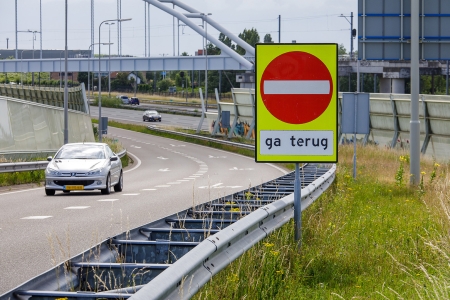Wrong-way drivers primarily involve drivers of passenger cars. Wrong-way driving crashes occur in all age groups, but older drivers are overrepresented. To a slightly lesser extent, the same is true of young drivers. Among wrong-way drivers there are relatively many people with mental health issues and those who intentionally drive the wrong-way as a suicide attempt. Studies from several countries show a similar picture [2] [5] [6] [7] [8] [11] [12].
Gender
The effect of gender is unclear [13]. In the United States, some researchers found that men are overrepresented in wrong-way driving crashes (e.g.: [12] [14]), but other researchers did not (e.g., Lathrop et al., 2010 in [13]). Kemel [11] en Blokpoel & De Niet [2] saw no differences between men and women in France and the Netherlands, respectively, but Vias institute [4] again reports an overrepresentation of men for Belgium. Men were also strongly overrepresented in the recent study of wrong-way drivers in the Netherlands [1], although possibly not representative of all wrong-way driving crashes: 56 out of 68 wrong-way drivers were men. Since men drive more kilometres than women, these figures do not say anything about the risk of a wrong-way crash. A Swiss study [6] did look at this and found that the risk of a wrong-way crash was 1.5 times higher if the driver was a woman.
Older drivers
According to Scaramuzza & Cavegn [6] (Switzerland), the risk of a wrong-way crash is more than 7.5 times higher if the driver is older than 65. Kemel [11] (France) reports that drivers aged 65 or older are 15 times more likely to have a wrong-way crash than those aged 25 or younger. Zhou et al. [12] (United States) found that, on highways, drivers aged 65 or older were three times more likely to be involved in a wrong-way crash than in other crashes. Vias Institute [4] reports that in all injury crashes in Belgium between 2011 and 2020, 5% were older than 65, but in injury crashes due to wrong-way driving this amounted to 21%. Dutch figures from the 1990s show that in about 33% of wrong-way drives that resulted in a fatal crash or injury crash, the wrong-way driver was aged 70 or older [2]. In the 68 Dutch wrong-way driving crashes and incidents between 2015 and 2019 analysed for the SWOV police file study [1], in about 25% of the cases the driver was aged 70 or older. It should be noted, however, that the investigated wrong-way drives need not be representative of all wrong-way drives.
